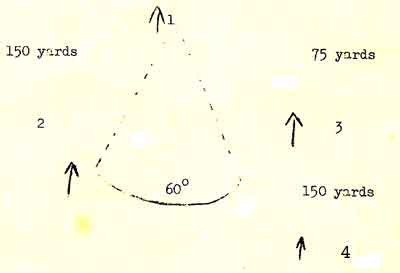RESTRICTED. Page 37
Formations to fly
9. The considerations of battle formation must be applied to suit the
varying needs.
(a) High Level. Battle formation will be flown in the normal high
level manner to give defensive cover at the discretion of the leader,
remembering that the ground strike is the primary object.
(b) Low Level. Various types of low level battle formation can be used.
depending upon the height chosen to fly. In general, the lower the
formation the sharper the "arrowhead". The following is a typical
formation.

Advantages.
(i) No. 3 ( deputy leader) close no No. 1 to follow the navigation.
(ii) Nos. 1 and 2, and Nos. 3 and 4, are together in pairs if forced
to break in defence.
(iii) Narrow frontage for penetration and avoidance of defended areas.
(iv) Turns can be absorbed by the formation without the need to cross
slipstream or lose sight of the leader.
(v) Look out and station keeping is fairly easy.
(vi) The formation can be kept very low
(vii) Nos. 2 and .4 are in the rear for defensive cover as required.
Disadvantages.
(i) Rearward cover is poor.
(ii) The leader has difficulty in keeping his formation in view.
/Approach
RESTRICTED. | 






